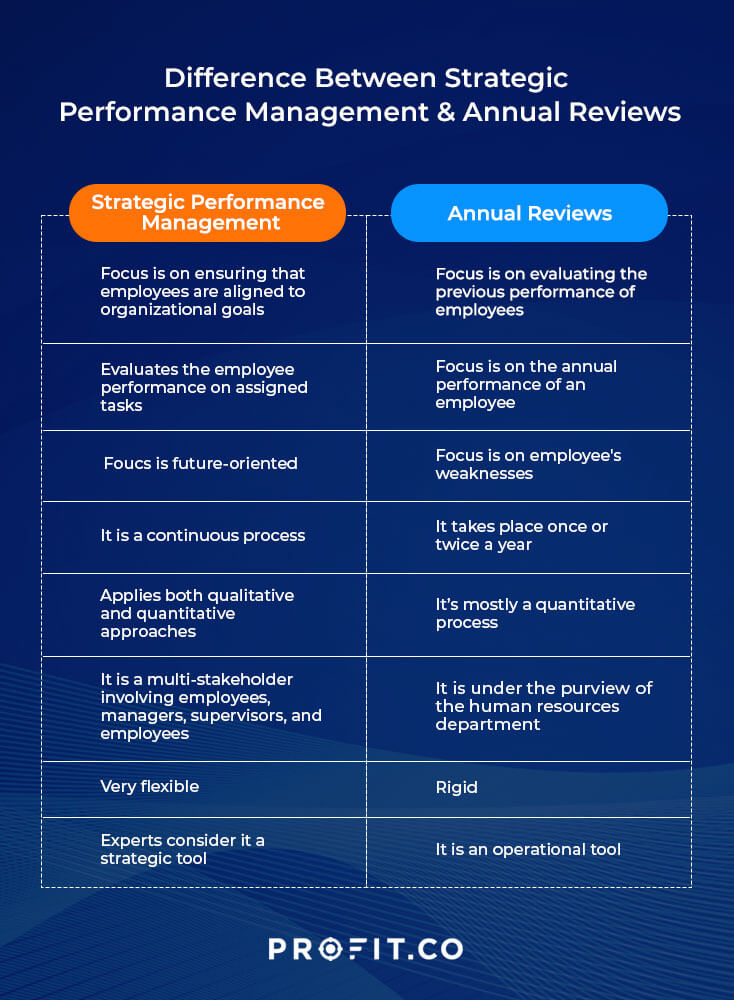Introduction
There is a big difference between reality and expectation and fixing it is integral to improving an organization’s performance. Strategy performance management helps fix this problem. An organization needs a clear strategy to succeed. However, all aspects of the organization must align with this strategy to achieve successful operations. Execution of a good plan is core to its success. Strategic performance management integrates employee efforts, behaviors, and continuous feedback to ensure seamless execution.
Strategic performance management means an organization aligns its overall organizational strategy with employees. Performance expectations, Information exchange and leadership, are aligned to guarantee that everybody works toward the same goal.
What Is Strategic Performance Management?
Does your organization have a concise business strategy? If so, every employee should be able to contribute to achieving the strategy. The employees should also be in a position to outline steps they are taking to achieve organizational goals. The strategic performance management method aims to improve performance measurement and monitoring to achieve overall objectives.
The approach enables the organization to meet its goals and objectives. To ensure your employees adopt and push your goals, your plan must have guidelines and expectations that are:
- Simple
- Realistic
- Appropriate
To ensure that every employee collaborates toward the same objective, strategic performance management aligns employees with the organization’s overall strategy by establishing a clear command structure and communication. Research is integral in strategic performance management. Using its findings helps a company craft better goals and realistic objectives that help it meet its objectives.
The Role of Performance Management System
In this strategic performance management framework, the role of a well-structured performance management system is of paramount importance. A performance management system is a comprehensive framework designed to ensure that an organization’s objectives are met efficiently and effectively. This system encompasses various processes, tools, and methodologies, all aimed at aligning individual and team performance with the organization’s strategic goals
I’m here to build something for the long-term. Anything else is a distraction.
In a nutshell, a strategic performance management process must:
- Communicate the organization’s vision and cascade the goals in an explicit, frequent, and transparent manner
- Establish work performance expectations, and make a strategy on how to realize them
- Through performance appraisals (feedback and check-ins), monitor employees’ performance
- In measuring performance, focus on other factors, not just Key Performance Indicators such as efforts, processes, behavior, abilities, and skills.
- Ensure that you provide feedback continuously and constructively. The feedback should be fair, accurate, and actionable.
- For optimal performance, continuously develop employees’ capacity
- Coach and design action plans to manage issues related to performance
- Must provide recognition and reward your employee efforts accordingly
Organizations can use the OKR methodology integrated with performance management to increase employee engagement in achieving Organizational strategy. Book a free demo with our team to learn more about how OKR software can optimize your organization’s performance!
Importance of Strategic Performance Management?
Interdependency among employees results as a benefit from strategic performance management. An organization without a proper strategy alignment will suffer from disorganization, conflicting differences and time, and resource wastage. Linking employee goals with company objectives results in a blow-up of efficiency and effective teamwork.
The likelihood that these symptoms will manifest almost entirely decreases when a business seeks to link individual employee goals with organizational goals. With the new system in place, the company notices an improvement in efficiency and productive collaboration, as well as timely project and task accomplishment.
Additionally, other benefits that will accrue from the process include the following:
- Greater employee satisfaction: employees run your organization. Employees’ personal development throughout the organization increases the effectiveness of your strategy.
- Exponential improvement of the organization: Departmental managers should be aware of all needs of their department. To effectively help their teams deliver on the company mandate, they must understand the initiatives, goals, and values they aim to achieve.
- It will result in better communication: Proper communication of the company strategy is key to delivering intended results. It helps employees reconsider their previous assumptions. As a result, employees become better problem solvers, critical thinkers, and decision-makers.
- Results in the creation of a culture of excellence: Through strategic performance management:
- The organization creates a strategy, after which
- Departments design precise tasks for its implementation.
- Employees align their actions and their processes toward its implementation
As a result, employees have a voice, and the management team’s work with all departments is more effective.

Annual Reviews Vs Strategic Performance Management
An annual review assesses a person’s performance and value to the company. Businesses use yearly assessments to determine the best performers, evaluate their progress, and reward them. Strategic performance management is a tool for corporate management. It enables managers to examine and evaluate the work of their personnel. It aids in fostering a culture where employees can give their all and deliver the best possible work quickly and skillfully.
It allows for contextualizing individuals within the larger workplace structure while emphasizing accountability and transparency. According to Simply Learn, it helps people understand expectations more clearly. Annual reviews and strategic performance management are distinct terminologies. The use of both strategies in an organization is advantageous to any organization.
| Strategic Performance Management | Annual Reviews |
|---|---|
| It focuses on ensuring that employees are better placed to perform for the betterment of the company. | Focuses on evaluation of previous performance. It also communicates to employees about their performance on current tasks. It doesn’t have a strategy for employee growth in the future. |
| Evaluates whether an employee has accomplished assigned tasks or goals or not. It also seeks to weed out any hindrances to peak performance. | Only focuses on the annual performance of an employee and gives feedback. |
| It is more future-oriented, looking at how the employee can perform better going forward. | Evaluates an employee’s weaknesses and provide avenues for better performance |
| It is a continuous process between managers and employees, sometimes through day-to-day conversations. | At most, it takes place twice a year. |
| Applies both qualitative and quantitative approaches with the intent of enhancing employee performance. | It’s mostly a quantitative process. |
| It is a multi-stakeholder proves involving employees, managers, supervisors, and employees who take part in everyday processes. | It is under the purview of the human resources department. |
| Very flexible | Rigid |
| Experts consider it a strategic tool. | It is an operational tool ideal for enhancing the efficiency of employees. |
Strategic Performance Management
Strategic Performance Management is the ongoing, systematic and objective assessment of results achieved by an organization in order to improve them.
Steps to Implement Strategic Performance Management
Technology is critical in strategic performance management, according to Clear Point Strategy. It allows you to quantify, monitor, and visualize your strategic goals.
To effectively manage your strategy, you have to:
- Analyze your business goals
- Perform data analysis and examine the results to gauge your performance
- Identify your weaknesses and the areas in need of improvement
- Implement the strategy while tracking it to ensure that it is performing according to expectations
Consider using the balanced scorecard to analyze your goals. It is a trusted system in strategic planning and management.
Five Things to Keep in Mind
According to Spring HR, to ensure that your strategic performance management is successful, keep in mind these five things:
1. Communicate the organization’s goals and performance objectives
Employees cannot gauge their performance without properly outlining company goals and performance objectives. It is impossible to tell if they succeed or fail in their targets.
2. Offer performance feedback regularly
Real-time feedback, the use of goal-tracking software, and regular one-on-one meetings can help you monitor progress. The use of more than one of these strategies builds employee confidence by assuring them that they are on the right track.
A solid performance management strategy must include effective performance feedback. It helps to develop desirable behavior and reaffirm sturdy skills and abilities. It also offers a chance to show employees the way toward a defined course for growth and development. Consistent feedback is the right approach to reassure your staff and validate their initiatives.
3. Make use of performance management software
Due to a fast-evolving technological world, previously used performance management systems are obsolete. To foster employee development in a dynamic world, source software that is:
- Employee-friendly,
- It makes use of a simple and intuitive dashboard interface
- Has room for prompt and actionable reporting
4. Utilize a 360 Degree review system
The 360 Degree review system, also called a multi-rater system, is a more modern approach to getting feedback on performance. The system seeks to include peers, customers, direct reports, and colleagues. Compared to a single perspective from a manager, this system allows for a more encompassing feedback mechanism.
Once the system presents summary results, the system can encourage employees to self-reflect. To ensure constructive feedback, confidentiality, and respect, the organization should incorporate the HR department to offer oversight.
5. Hold regular one-on-one meetings to review outcomes and results
Setting time aside to check in with your team to monitor progress on goal achievement is essential. The frequency of these meetings varies depending on the organization. Mandatory attendance at these meetings ensures that the feedback is accurate and up to date.
Examples and FAQs
Peer-to-peer feedback is a critical component of Facebook’s strategic performance management strategy. Semi-annual assessments use this feedback to assess how well teams are performing. Additionally, Facebook has internal software that offers real-time feedback to ensure the resolution of problems before they escalate.
Conclusion
Any human resources department’s core function is to regulate performance management. Businesses should concentrate on producing successful overall performance with the assistance of those who helped get them there. You can establish a productive workplace by using employees’ skill sets, acknowledging their accomplishments, supporting them when they struggle and recognizing them as valuable players. The OKR framework integrated with performance management can help organizations in their journey to improve strategy performance management. Contact us today for a free demo to learn how OKR software transforms your business and enables you to achieve optimum performance to bridge the strategy execution gap.

